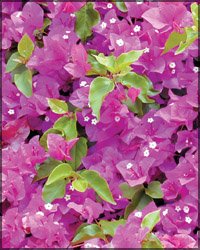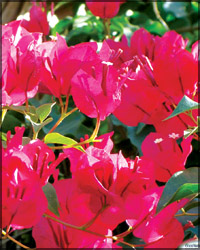|
Flowers and
Pets |
Compiled by Sachitra Mahendra |
Flowers of Sri Lanka:
Bougainvillea
The flower needs a little water:
Manoj DISSANAYEKE
|

Multi-coloured Bougainvillea |

Bougainvillea spectabilis |
|

White Bougainvillea |

Red Bougainvillea |
Bougainvillea was first brought to Sri Lanka by the British; it is
called the traditional variety. This variety is at least 15-20 feet
high. The traditional variety has its own pros and cons. It needs at
least a space of 3-4 perches of land, since it easily spreads fast.
Bougainvillea has a new variety grown up in Sri Lanka that can be
even potted. It blossoms in even at a tender age. The new variety of
Bougainvillea consists of 16 colours. The foliage is so pretty looking.
|
Common pests & diseases
On the rare occurrences that your bougainvillea
experiences pest problems or disease, always try the least
toxic method of pest control as your first step. If you use
chemical pesticides to control insect pests, you will also
kill natural predators.
If you choose a chemical control, follow directions and
guidelines closely and always wear protective clothing and
safety gear including a long-sleeved shirt, long pants,
neoprene gloves, goggles and a respirator. Chemical
pesticides are not recommended for use inside the home.
|
Bougainvillea is a genus of flowering plants native to South America
from Brazil west to Peru and south to southern Argentina (Chubut
Province). Different authors accept between four and 18 species in the
genus. The name comes from Louis Antoine de Bougainville, an admiral in
the French Navy who discovered the plant in Brazil in 1768.
They are thorny, woody, vines growing anywhere from 1-12 meters tall,
scrambling over other plants with their hooked thorns. The thorns are
tipped with a black, waxy substance that is easily left in the flesh of
an unsuspecting victim. They are evergreen where rainfall occurs all
year, or deciduous if there is a dry season.
The leaves are alternate, simple ovate-acuminate, 4-13 cm long and
2-6 cm broad.
| Bio Data
Kingdom: Plantae
Division: Magnoliophyta
Class: Magnoliopsida
Order: Caryophyllales
Family: Nyctaginaceae
Genus: Bougainvillea
|
The actual flower of the plant is small and generally white, but each
cluster of three flowers is surrounded by three or six bracts with the
bright colours associated with the plant, including pink, magenta,
purple, red, orange, white, or yellow.
Bougainvillea glabra is sometimes referred to as “paper flower”
because the bracts are thin and papery. The fruit is a narrow five-lobed
achene.
Bougainvilleas are relatively pest-free plants, but may suffer from
worms and aphids.
The larvae of some Lepidoptera species also use them as food plants,
for example the Giant Leopard Moth.
Bougainvilleas are popular ornamental plants in most areas with warm
climates, including Indonesia, India, Taiwan, Vietnam, Malaysia,
Australia, the Mediterranean region, the Caribbean, Mexico, Panama,
South Africa, and the United States in Arizona, California, Florida,
Hawaii, and southern Texas.
Numerous cultivars and hybrids have been selected, including nearly
thornless shrubs. Some Bougainvillea cultivars are sterile, and are
propagated from cuttings.
Bougainvillea are rapid growing and flower all year in warm climates,
especially when pinched or pruned. They grow best in moist fertile soil.
Bloom cycles are typically four to six weeks.
Bougainvillea grows best in very bright full sun and with frequent
fertilization, but the plant requires little water to flower. As indoor
houseplants in temperate regions, they can be kept small by bonsai
techniques. If overwatered, Bougainvillea will not flower and may lose
leaves or wilt, or even die from root decay.
The writer is an Agriculture Instructor at Peradeniya Botanical
Gardens
Green fingers:
I’ve found my childhood friend!
Ravindu Mahendra
Last week I introduced my childhood friend Niyagala flower and my
childhood memories around it. It was very hard for me to convince my
mother or anyone else to fall in love with it as it was a well known
toxic plant, so I had to leave them alone.
 Years
went by and one day I was flicking through my A-Level botany text book
and found my childhood friend again. It was there because of its unusual
habit of climbing. I found out its botanical name was Gloriosa superba
and that it belongs to Liliaceae (lily family) family. Years
went by and one day I was flicking through my A-Level botany text book
and found my childhood friend again. It was there because of its unusual
habit of climbing. I found out its botanical name was Gloriosa superba
and that it belongs to Liliaceae (lily family) family.
A few years ago I saw Niyagala flowers as cut flowers in a florist in
London. The florists call them ‘glory lily’. I began to wonder where
they came from. It was my understanding that they never grow in British
gardens apart from in a green house with suitable temperature and
humidity for tropical plants.
I started gathering more information. ‘Gloriosa’ was believed to come
from ‘glorious’, and superba from ‘superb’ alluding to the most unusual
magnificent flower which holds flame like petals. Some people call it
Flame lily. Too many names ……! So let me call the Niyagala flower Glory
lily from now on.
Glory lilies naturally occur in semi-shade areas among bushes in
tropical climates. Mainly native to tropical jungles of Africa and
related species are found in Asia. The peak flowering season November to
March though I’ve seen some flowering throughout the year until its
dormant period comes. Once the vine has finished flowering the foliage
turns yellow and dies down not leaving a single little sign of life.
Glory lily tubers can stay dormant for a few months and come back with a
great display over and over again if kept undisturbed.
Some countries grow lily commercially to extract chemical compounds.
The chemical compounds found in Glory lily are believed to take a vital
part in some of the tribal medicines for infertility, skin problems and
impotence. My mother was right anyway: research suggests all parts of
this plant, both above and below the ground are extremely poisonous and
ingestion could be fatal……!
Last Autumn I planted various kinds of spring flowering bulbs and
tubers including snow drops, tulips, daffodils, hyacinths and some
lilies. While I was reading the planting instructions on the packet
labels my eyes were drawn to the warning sign for the customer. Many
packet labels warn the customer not to consume the bulbs and tubers as
they can be harmful.
 Winter
now gradually turns into spring. The bulbs and tubers I planted last
Autumn are starting to sprout with glory. When the spring flower display
finishes, the summer display should be ready. So I have to do more
homework now as this is the time to order summer bulbs and tubers. I’m
spoilt with a huge range of choice with too many flower catalogues
available. All I have to do is spend lots of money and feel guilty for a
little while until the plants start growing. Flicking through a
catalogue to order some lily bulbs, my eyes accidentally bumped again
onto a familiar face. Glory lily is available to grow in British gardens
with lots of instructions how to grow and look after as it is a tropical
plant and the climatic conditions would not be friendly enough for them
as they would be in Sri Lanka or Africa. To my surprise the catalogue
did not mention about any toxicity. (I presume people tend not to
experiment with exotic flower bulbs anymore as there are plenty of other
edible choices.) Winter
now gradually turns into spring. The bulbs and tubers I planted last
Autumn are starting to sprout with glory. When the spring flower display
finishes, the summer display should be ready. So I have to do more
homework now as this is the time to order summer bulbs and tubers. I’m
spoilt with a huge range of choice with too many flower catalogues
available. All I have to do is spend lots of money and feel guilty for a
little while until the plants start growing. Flicking through a
catalogue to order some lily bulbs, my eyes accidentally bumped again
onto a familiar face. Glory lily is available to grow in British gardens
with lots of instructions how to grow and look after as it is a tropical
plant and the climatic conditions would not be friendly enough for them
as they would be in Sri Lanka or Africa. To my surprise the catalogue
did not mention about any toxicity. (I presume people tend not to
experiment with exotic flower bulbs anymore as there are plenty of other
edible choices.)
What a glory! I have found my childhood friend again and this time
I’m not going to lose him but get close carefully without any fear. I
might have to grow my Glory lily inside the conservatory if we get a
cold summer here like we had last year.
I love and adore all the flowers and some sorts are more favourite
than others. I think all the flowers are amazing! We see plenty of wild
flowers in Sri Lanka, yet we don’t even look at them. I think we should
get close to these invisible beauties more. We can then appreciate and
understand the way that mother nature smiles!
[email protected]
My notes on Samson - 6
It seemed like our family got a new-born, from the moment Samson Jnr
stepped out of my brother’s lap. Father, mother, two brothers and
myself, everybody had a good time cuddling him.
 The
dorky duke seemed scared to be in a strange place; his mother was far
away now. I was wondering whether his tiny bites were to protest. Anyway
I loved to have my fingers bitten whenever I get closer to him. The poor
fellow’s biting practice was not a success as it did not pain any of us.
Seeing it fail, the blue blood kid used to run out if he saw something
fishy of us when getting closer to him The
dorky duke seemed scared to be in a strange place; his mother was far
away now. I was wondering whether his tiny bites were to protest. Anyway
I loved to have my fingers bitten whenever I get closer to him. The poor
fellow’s biting practice was not a success as it did not pain any of us.
Seeing it fail, the blue blood kid used to run out if he saw something
fishy of us when getting closer to him
I think you remember what made us buy a Dobermann; my mother had a
very good protection by the senior fellow who used to scare away
strangers by his fierce barking. Anybody with an urgent matter had to
give a call before visiting us. This might have sounded a little
inhuman, but it was the probable defence mechanism when we used to hear
lots of stories of strangers asking for a glass of water and then grab
the chance to take the lady householder’s life.
The junior fellow seemed to have started his duty too. You will have
loved to hear the little one’s barking. He could even growl when he want
to be let alone. I loved stroking his pug-like snout.
Enough snogging. We have duties to dole out on Samson Jnr.
[email protected]
Shoot for fun ’n’ fame
“Hi folks today me and my faithful companion, Lucky will demonstrate
to you the best self-technique of the era.”
“First you observe your target...”
“Put on your most ferocious scowl....”
“Aim at your enemy with the deadly left hand stab. Meow...”
Cat attack! Lucky and Kitty are new members of the household and it
seems that Kitty had not taken too kindly to Lucky. Talk about being
unlucky on his first move.
Pictures by Mahinda Vithanachchi
Words by Ruwini J.
|

